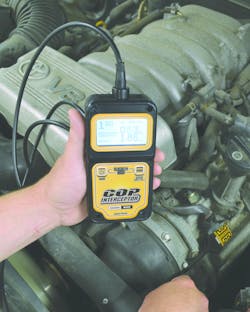The Hickok/Waekon COP Interceptor, No. 76564, provides advanced ignition diagnostics over and above scan tools and is simpler than an oscilloscope to operate, according to the company. The Interceptor measures, displays and can save each coil on plug’s secondary ignition data in real-time for detailed ignition analysis. View trend data for visual verification of intermittent misfires that may not set codes. The auto-set function means the 76564 works on multiple styles of COP ignition systems.
The Review
Lou Fort, lead technician at K.A.R.S. Inc., recently tested the Hickock/Waekon COP Interceptor on several jobs at his Huntingburg, Ind.-based shop. According to Fort, the tool gets easier to use with time, especially if the user takes a few simple steps to ensure reliable results.
“There is a learning curve to understanding some of the readings taken at different levels of sensitivity,” says Fort, who also emphasizes the importance of reading and re-reading the user manual prior to employing the COP Interceptor on jobs. “There are four of them (readings). It took me just a few uses and confirmations of my interpretations of the readings to quickly confirm my diagnostics and be very comfortable using the tool.”
According to Fort, the tool requires the user to do a number of things prior to employing it in the shop. First, the probe must be connected to the unit. Then one of two different probe tips must be selected, and the unit must be powered by pressing the left “Save” button. The user must then calibrate the tester using ”Auto-Set” by pressing and holding the right “Setup” button to access the menu.
“You can skip this step, but I wouldn’t recommend it,” says Fort. “Then follow the instructions found in the manual to begin testing. Once, you have read the manual and used the tool, all of this can be done in under 30 seconds.”
Fort is quick to note that the information found in the manual isn’t difficult to read or understand, but that he doesn’t trust what he thinks he has read until he has re-read it and confirmed it.
Of features Fort liked, he commented on using the "Trend View" frequently.
"The one feature I have been using the most is the ‘Trend’ view. I have been doing the full deal by taking each cylinders reading in ‘Digits View,' followed by switching to the ‘Balance View,' then moving on to the ‘Trend View.'" he says. "The ‘Trend View’ is the one I like and use the most. I also like how I can use the tool to find dead holes in non-COP systems. Having both the KV and MS burn-time displayed on each readings screen is extremely handy."
The COP Interceptor was used by Fort on a number of vehicles, including a Ford F-Series, a Chevrolet C&K Series, a Toyota, a Mitsubishi and Audi, among others.
He even employed it on non-COP ignitions and power/waste setups.
“One good example is a Ford Escape that had a dead miss,” he says. “I found the bad cylinder in under a minute and knew it wasn’t an issue in under two minutes.”
According to Fort, a running compression test with a pressure transducer hooked to the scope determined a burnt exhaust valve was the cause of the miss.
“That vehicle only had a P0300,” he says. “Mode 6 misfire data did point to No. 1 as a possible problem, as did No. 3, and the 'check engine' light was not flashing.”
While Fort has used a previous version of the tool, he says the COP Interceptor offers quite a bit more than its predecessor.
“This new one with the digital display brings it up to a whole new level,” says Fort. “The original had a steep learning curve and wasn’t always the most reliable, whereas this version has so far proven very reliable.”
Despite his appreciation for the tool’s features, Fort is concerned about how well the tool is protected from an inadvertent direct KV hit.
“In short, will the tool survive, say, a direct KV spike from a bad coil?” asks Fort. “Would having a shielded ground clip be of any benefit?”
Currently one button provides access to the menu and tool functions. For suggested improvements, Fort thought having a separate button to access the menu would be beneficial. He also mentioned adding an additional pouch to the carrying case, in order to hold the test leads, as well as a clip to hold the pad to the coil while the tool was in use. "It would be nice to free up both of my hands."
Nevertheless, he gave the COP interceptor a rating of 10 out of 10 “without any hesitation.”
Adds Fort, “It’s fast, easy enough to set up and use.”

